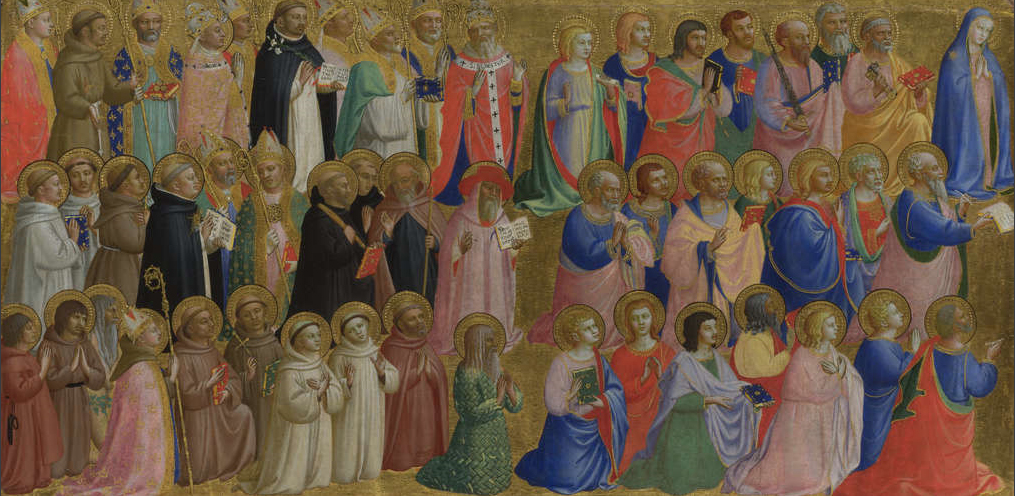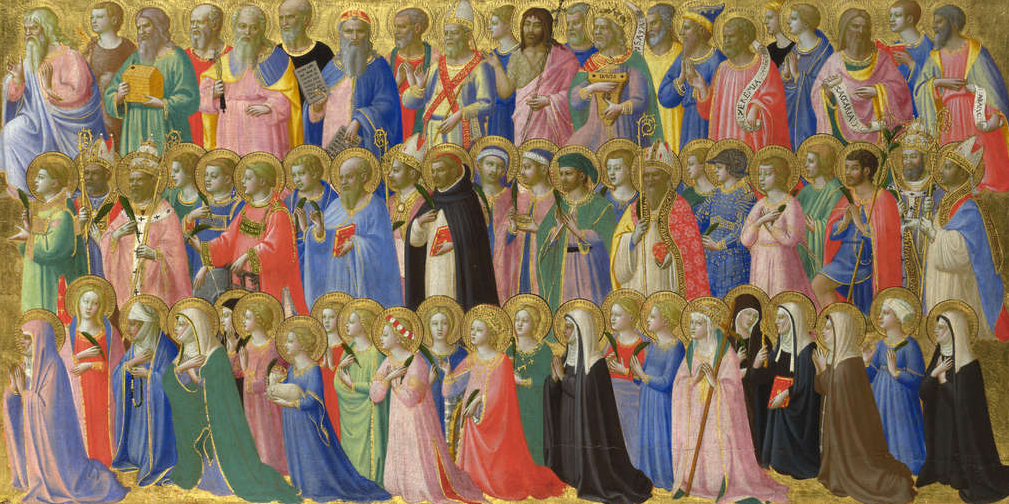March 30: Perfect Human Beings Formed in the Image of Christ
♫ Music:
Saturday, March 30
Perfect Human Beings Formed in the Image of Christ
Scripture: Hebrews 12:22-23
But you have come to Mount Zion and to the city of the living God, the heavenly Jerusalem, and to innumerable angels in festal gathering, and to the assembly of the firstborn who are enrolled in heaven, and to God, the judge of all, and to the spirits of the righteous made perfect,
Poetry:
Temple Gaudete
by Lisa Russ Spaar
Deus homo factus est
Natura mirante.
Is love the start of a journey back?
If so, back where, & make it holy.
Saint Cerulean Warbler, blue blur,
heart on the lam, courses arterial branches,
combing up & down, embolic,
while inside I punch down & fold a floe
of dough to make it later rise.
On the box, medieval voices, polyphonic,
God has become man, to the wonderment
of Nature. Simple to say: there is gash,
then balm. Admit we love the abyss,
our mouths sipping it in one another.
At the feeder now. Back to the cherry, quick,
song’s burden, rejoice, rejoice.
O salve & knife. Too simple to say
we begin as mouths, angry swack,
lungs flooded with a blue foreseeing.
Story that can save us only through the body.
THE JOURNEY OF BECOMING
‘A great journey is a reflection of who we are. It forces us to shed layers, to become aware of who we are and to discover our true self.’
Ana Alcaide, “La Cantiga del Fuego-El Viaje”
Liminality; “betwixt and between.” A journey can be like that. On the way to somewhere, not yet arrived, living in a place where you don’t quite fit, and where their ways are a mismatch for deeper values, longings and even identity. Ana Alcaide, from my adopted home of Spain, is inspired by the journey of the Sephardic Jews, exiled from the Holy Land. She senses that they never quite reached the place they were meant to be, were never really home.
Like the Sephardi, we also are on a journey, “foreigners and strangers on earth (Heb. 11:13),” living in the “already and the not yet.” Like the heroes of faith listed in Hebrews 11, we have not yet experienced the fullness of God’s promise or the fullness of the Kingdom. We have not yet arrived home. And we have not yet experienced the fullness of our own true humanity.
It seems that the folks addressed in Hebrews had been finding that the journey was not an easy one. The temptation to give up, to resort to the ways of the world was great. Nor is it easy for us. Our hearts can be fickle, flitting here and there, looking for satisfaction, not unlike the Cerulean Warbler. And in that place, we can discover much about ourselves. Self-discovery is good--it leads to an understanding of our frailty and our need. But the better discovery…Deus homo factus est, natura mirante; God has become man, to the wonderment of nature.
Over and over, the author of Hebrews reminds us of this reality and its marvelous ramifications. Jesus is the exact representation of God, above all created beings, and fully human. In fact, the exemplar of fully human. He was faithful, suffered, was the once for all sacrifice for our infidelity, and was finally seated at the right hand of Majesty. He was/is the “pioneer and perfecter of faith” (Heb. 12:2).
We are further told that as we suffer, and persevere, as we follow the path of our pioneer, God forms us into who we are meant to be, namely, like Jesus. Apparently, the journey in relationship with Jesus is the very place of becoming fully human, of entering into our true identity. And to top it off, the author culminates his exhortation; “…you have come to Mount Zion and to the City of the Living God…” He talks like it’s a done deal. Like we’ve already joined Jesus in his and our new home. Can it be true that the journey, that becoming, and being at home exist in the same time and space?
Prayer:
Lord, Jesus, I affirm that you are the exact representation of God
…help me become a true worshipper
I affirm that you are above all created beings
…help me become one who magnifies you above all else
I affirm that you are the once for all sacrifice for my sins
…help me become humble and full of gratitude, fully dependent on you
I affirm that you are the pioneer and perfecter of faith
…help me become a faithful follower
I affirm that you are fully, amazingly human
…help me become like you
Amen
Debbie Schuster
Director of SentWell
For more information about the artwork, music, and poetry selected for this day, we have provided resources under the “About” tab located next to the “Devotional” tab.
About the Artwork:
Predella of the San Domenico Altarpiece Fiesole, 1423-1424
Fra Angelico
Tempera and gold on wood panel
32 cm x 244 cm
National Gallery, London
The Convent of San Domenico is a Dominican convent in Fiesole, Italy. Fra Angelico was a friar there and painted several artworks for the convent, including the Fiesole Altarpiece and the Coronation of the Virgin (now in the Louvre). The San Domenico Altarpiece at Fiesole adorned the high altar, located in the choir, where the friars sang hymns as they celebrated the Liturgy of the Hours. Only the friars would have been privileged to view the predella (the platform on which an altar stands) in all its detail, as they knelt before the altarpiece. Nearly 300 miniature angels, Old Testament prophets, New Testament saints, and Dominican notables adorn the predella. The figures turn toward the central panel, where the resurrected Christ ascends heavenward among throngs of angels acclaiming his majesty with music and prayer. The predella is now separated from the altarpiece and is exhibited in the National Gallery in London, England.
About the Artist:
Guido di Pietro known as Fra Angelico (1395-1455) was one of the great masters of the Early Italian Renaissance. Born in the countryside of Florence, Guido di Pietro was already an established artist when he joined the Dominican order sometime between 1419 and 1422. He not only received commissions for important altarpieces from his own monastery, San Domenico in Fiesole, but from other Dominican houses in Florence, Cortona, and Perugia, and from religious institutions as far away as Orvieto and Rome. Known for his pious treatment of biblical subjects--which he portrayed with unprecedented psychological understanding and a compelling realism, the artist-monk was first called Fra Angelico or “the Angelic Painter” shortly after his death in 1455. Known as the patron of artists, in 1982 Pope John Paul II proclaimed Fra Angelico to be “Blessed.”
About the Music:
“La Cantiga del Fuego - El Viaje (The Song of Fire - The Voyage)” from the album La Cantiga del Fuego
Composer and the Performer:
Ana Alcaide (b. 1976) is a Spanish performer, composer, and music producer who researches ancient musical traditions and cultures. In 2000, Alcaide travelled to Sweden where she was first exposed to the Nyckelharpa, a traditional Swedish instrument that dates from medieval times. Attracted by the complexity and depth of its sound, Alcaide taught herself how to play the nyckelharpa on the streets of Toledo, Spain. In 2005, she returned to Sweden to further pursue her music studies and to specialize in the nyckelharpa. She graduated from Malmö Academy of Music after completing a program that focused on folk and world music. Alcaide has recorded three albums of traditional folk music.
About the Poet:
Lisa Russ Spaar (b. 1956) received a BA from the University of Virginia in 1978 and an MFA in 1982. She is the author of several poetry collections, including Orexia (2017), Vanitas, Rough (2012), and Glass Town (1999). The Boston Review notes, “Lisa Russ Spaar’s intensely lyrical language—baroque, incantatory, provocative—enables her to reinvigorate perennial subject matter: desire, pursuit, and absence; intoxication and ecstasy; the transience of earthly experience; the uncertainties of god and grave; the dialectic between fertility and mortality.” She is also the author of The Hide-and-Seek Muse: Annotations of Contemporary Poetry (2013), a collection of poetry history and criticism, and she was a 2014 finalist for the National Book Critics Circle Citation for Excellence in Reviewing. She has edited multiple poetry anthologies, including Monticello in Mind: Fifty Contemporary Poets on Jefferson (2016). Spaar has received a Guggenheim Fellowship, the Library of Virginia Award for Poetry, and a Rona Jaffe Award, among other honors and awards. She is a professor of English and Creative Writing at the University of Virginia.
About the Devotional Writer:
Debbie Schuster
Director of SentWell
Debbie Schuster is a Spiritual Director, graduate of Talbot and current PhD student at the Cook School of Intercultural Studies at Biola University. Based in Spain, she co-leads SentWell, a multidisciplinary missionary care team serving cross-cultural workers around the world. She is also the proud mother of 3 daughters, 2 sons-in-law, and 7 grandchildren.



